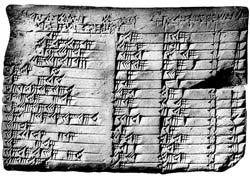-
It is believed that Ancient Egyptians used complex mathematics such as algebra, arithmetic and geometry as far back as 3000 BC, such as equations to approximate the area of circles.
-
Babylonians measured the circumference of a circle as approximately 3 times the diameter, which is fairly close to today’s measurement which uses the value of Pi (around 3.14).
-
Chinese mathematics developed around the 11th century BC and included important concepts related to negative numbers, decimals, algebra and geometry.
-
Greek mathematics developed from around the 7th century BC, producing many important theories thanks to great mathematicians such as Pythagoras, Euclid and Archimedes.
-
The Hindu-Arabic numeral system began developing as early as the 1st century with a full system being established around the 9th century, forming the basis of the numerical digits 0, 1, 2, 3, 4, 5, 6, 7, 8 and 9 that we use today.
-
The symbols used for addition (+) and subtraction (-) have been around for thousands of years but it wasn't until the 16th century that most mathematical symbols were invented. Before this time math equations were written in words, making it very time consuming.
-
The equals sign (=) was invented in 1557 by a Welsh mathematician named Robert Recorde.
-
Mathematical developments increased rapidly around the time of the Italian Renaissance in the 16th century and continued through the scientific revolution of the 17th and 18th centuries, becoming increasingly abstract in the 19th and 20th centuries.
-
The basic arithmetic operations used in mathematics are addition, subtraction, multiplication and division.
-
Modern mathematics has advanced greatly thanks to the incredible computing power of today’s computers.
-
These days mathematics is important in many different types of jobs, including those related to engineering, business, science, medicine and more.
-
Check out our famous mathematician facts for more.
|

Babylonian tablet of Pythagorean triples
|